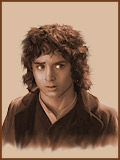
J.R.R Tolkien’s literary writings, especially Lord of the Rings, were influenced by his experience in World War I. Tolkien served in the British army as a Second Lieutenant from 1915 until the end of the war. As an officer he participated in several different aspects of the war including communications and front line action. His battalion took part in two major battles, Orvilles and the attack on Schwaben. During the war Tolkien began to develop the stories of Middle Earth that would later on become Lord of the Rings. (May 2010. Croft, Janet. "The Great War and Tolkien's Memory." Mythlore (2002): n. pag. Web. 8 May 2010.) Many parallels referring to the war can be found in the story, however Lord of the Rings is not meant to be a direct allegory, as some claim, but rather an analogy. Tolkien himself made this clear and was very annoyed by those who stated otherwise.
Soldiers in combat experience a special kind of friendship often referred to as comradery. Tolkien experienced this kind of relationship in his days as an officer with the soldiers under his command. Every British officer had a “batman”, a soldier of a lower class who waited on him, took care of his belongings and acted much as a servant would. The character of Sam Gamgee was based off of the “batmen” who had served Tolkien throughout the war. “My Sam Gamgee”, said Tolkien,” Is indeed a reflection of the English soldier, of the private and batmen I knew in the 1914 war.”( Croft , Janet. "The Great War and Tolkien's Memory." Mythlore (2002): n. pag. Web. 8) In the story Sam is “Mr. Frodo’s” servant. He cooks for him, fetches water, makes the campfire and protects him from intruders while he rests. (Tolkien, J.R.R. The Lord of the Rings. 50th Anniversary Edition. New York: Houghton Mifflin Company, 2004. Print. ) Their friendship is similar to the comradery experienced by soldiers. It not ruined by the horror they experience together but rather strengthened by it.
The trenches of WWI were gruesome places. Soldiers returned home with stories of horror concerning their experiences there. J.R.R.Tolkien spent part of the war in trenches on the frontline where he contracted a fever that kept him off the battlefield for much of the war. When creating the landscapes for Mordor and the Dead Marshes Tolkien drew from this experience. (Croft, Janet. "The Great War and Tolkien's Memory." Mythlore (2002): n. pag. Web. 8)The battlefields of WWI were polluted with the rotting bodies of dead men and animals sinking into the mud. When traveling through the Dead Marshes Frodo and Sam see the faces of those fallen in battle. Old and decaying, hideous to behold yet once looked upon their gaze could not be drawn from them. (Tolkien, J.R.R. The Lord of the Rings. 50th Anniversary Edition. New York: Houghton Mifflin Company, 2004. Print.) In a letter Tolkien wrote,” The Dead Marshes and the approaches to the Morarnnon owe something to northern France after the Battle of the Somme”. (Croft, Janet. "The Great War and Tolkien's Memory." Mythlore (2002): n. pag. Web. 8) Mordor resembles “no-man’s land”, the area between the German and Allied trenches. No-man’s land was entrenched with fuming potholes caused by artillery shells much like the one Sam and Frodo hid in during a scene in The Two Towers. The battlefield was deprived of life, like Mordor it’s only inhabitants were enemy soldiers and dead, barren trees. The battlefield reeked of smoke from artillery, Mordor from the fumes of Mount Doom. Just as the horror of the battlefield landscape was caused by man’s misuse of technology so to the desolation of Mordor was not caused by nature but was the work of evil minds.
World War I marked the end of a golden age in Europe. Similarly the destruction of the one Ring brought about the end of the third age in Middle Earth. The third age was a high culture of music and art created by the elves and dwarfs. Their power diminished with the destruction of the Ring and these ancient peoples began to fade. Middle Earth was then left in the hands of men who had to preserve what was left of beauty in the world after the Great War. The fourth age was a lesser one, as was the new age that began in Europe after WWI. The rise of Communism and Fascism, the Cold War and the raising of the Berlin Wall were some of the events that followed the 1914 war. The evils that started it, unlike the Ring, had not been defeated
Some critics of Lord of the Rings claim that it is an allegory of World War I. An allegory is a story in which people, things and events have a hidden symbolic meaning meant to teach a moral lesson. C.S Lewis’s stories about Narnia are direct allegories to the Bible meant to teach children the story of redemption. Tolkien strongly disagreed with this method of instruction and never used it himself. “As for any inner meaning or 'message', it has in the intention of the author none. It is neither allegorical nor topical... It was written long before the foreshadow of 1939 had yet become a threat of inevitable disaster, and from that point the story would have developed along essentially the same lines, if that disaster had been averted.” (Croft, Janet. ""The Young perish and the Old Wither Lingering": J.R.R Tolkien on World War II." Mythlore June (2003): n. pg. Web. 11 May 2010.) Once it was suggested by a Swedish commentator that Saruman was meant to represent Joseph Stalin. Tolkien then clearly stated that nothing he wrote was a direct reference to any person or world event. “Such an allegory is entirely foreign to my thought,” he retorted. (Croft, Janet. "The Great War and Tolkien's Memory." Mythlore (2002): n. pag. Web. 8)Tolkien’s writings were analogies. An analogy is a partial resemblance between subjects usually considered unalike. Lord of the Rings is an analogy about evil and goodness, darkness and light. The War of the Ring has similarities to WWI but does not refer directly to it; in fact there are many differences. As well as being influenced by WWI, J.R Tolkien was also affected by WWII, Communism, total war methods and industrialization. All of these ideologies are found in Lord of the Rings. His dislike of modern technology is very clearly expressed, especially in the scourging of the Shire, which takes place in Return of the King, as well as in the character of Saruman and his industrialized city of Insengard.
The success or failure of a battle is not merely determined by who wins or loses. The total loss of human life must also be considered. Many battles of WWI were literally human blood baths. Some critics say that the whole war was a purposeless waste of human life and that it could have been avoided. Both sides suffered heavy causalities. All of Europe was broken and divided, whole cities wiped out and destroyed. Enmity was planted in the hearts of many and came to full bloom with the outbreak of World War II a decade later. Similarly, the war in Middle Earth cost the lives of many, including great leaders such as Theoden, King of Rohan, and Boromir, son of the Steward of Gondor. The war would never defeat the Dark Lord as Gandulf said in the first half of the book,” Always after a defeat and a respite, the shadow takes another shape and grows again.” (Tolkien, J.R.R. The Lord of the Rings. 50th Anniversary Edition. New York: Houghton Mifflin Company, 2004. Print.) Only through the destruction of the one Ring was the power of Sauron defeated. The only solution to war and conflict is not more violence but conversion. When selfishness and greed are uprooted from men’s hearts then the world will know peace but while it remains conflict and enmity between peoples will continue.








Your posts are very interesting
ReplyDeleteThank you very much!
ReplyDelete